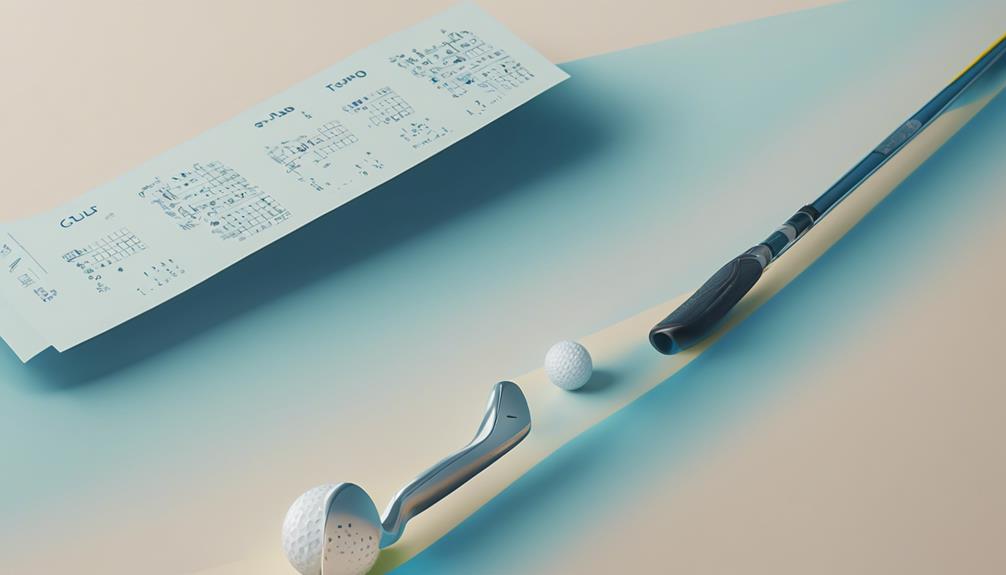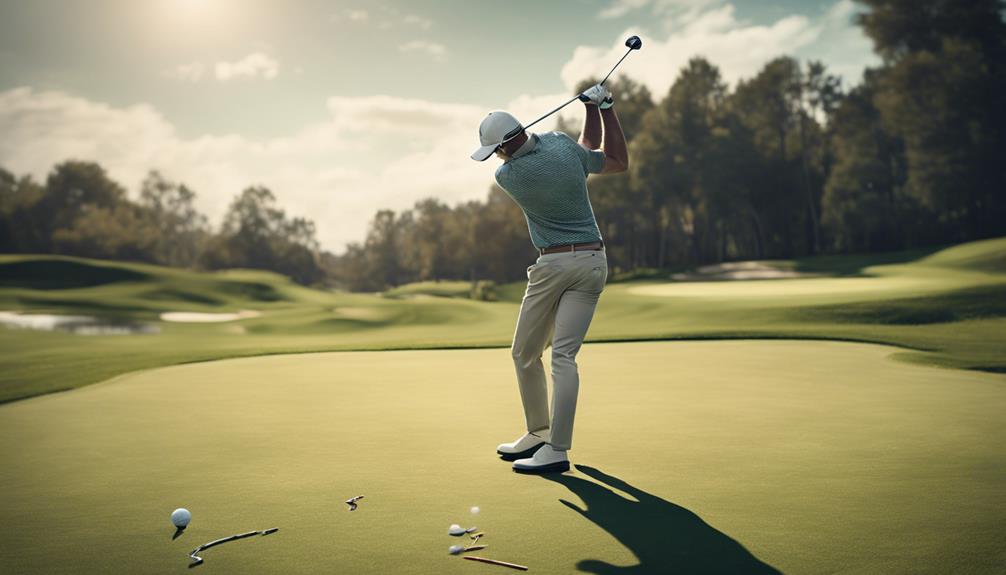- 7 Top Flite Golf Clubs XL for Improved Performance - September 28, 2024
- Top Flite Golf Clubs: Top 5 Reasons to Choose Them - September 28, 2024
- Top 3 Golf Club Fitters for a Perfect Swing - September 28, 2024
As you grip a golf club, the shaft and head work in harmony to convert your swing into kinetic energy, propelling the ball forward. The club head's design, including loft angle and sweet spot, plays an essential role in energy transfer, affecting distance and accuracy. The shaft's material and stiffness, tailored to your swing characteristics, further influence the shot's outcome. With various club types, each engineered for specific distances and situations, understanding their unique features and technologies is key to optimizing performance. As you explore the intricacies of golf club design, you'll reveal the secrets to mastering your game.
Key Takeaways
- A golf club consists of three main components: grip, shaft, and head, each designed for comfort, control, and energy transfer to the ball.
- The club head's design, including loft angle and sweet spot, affects energy transfer, distance, and accuracy of the shot.
- The shaft's material and stiffness are tailored to a golfer's swing characteristics, influencing the club's overall performance.
- The sweet spot on the club head is crucial for achieving optimal distance and accuracy, and its location varies by club type.
Club Components and Design
When you hold a golf club, you're grasping a sophisticated tool comprising three essential components: the grip, shaft, and head, each precision-engineered to work in harmony to deliver a consistent and powerful swing.
The grip, typically made of rubber or leather, fits comfortably in your hands, allowing for precise control.
The shaft, connecting the grip to the head, can be made of steel or carbon-fiber composite, and its stiffness rating is tailored to your individual swing characteristics.
The club head, which varies in design according to club type, is responsible for transferring energy to the golf ball. Its design features, such as the club face, center of gravity, loft angle, and sweet spot, all contribute to the club's performance.
The sweet spot, in particular, is the area where the ball should strike for best distance and accuracy.
With different types of golf club heads, each is precision-engineered to deliver a unique performance.
Types of Golf Clubs Explained
As you grasp your golf club, you're holding one of four primary types of clubs, each precision-crafted to tackle specific shot distances and situations on the course. Understanding these types is essential to mastering the game.
Here are the four main types of golf clubs:
- Woods: Designed for long shots, woods have larger heads and lower lofts (7-12 degrees). They're perfect for striking the golf ball over 175 yards.
- Irons: These versatile clubs are used for shots under 200 yards and come in a standard set of 3-9 irons, each with varying lofts for different distances.
- Wedges: With higher lofts (48-64 degrees), wedges are specialized for short shots around the green, providing greater control and spin.
Each type of golf club is engineered to work in harmony with your swing, allowing you to tackle various shot distances and situations with confidence.
Understanding Club Numbers and Loft

You grasp the significance of club numbers and loft as you realize that the numeric label on each club corresponds to the precise angle of the club face, which in turn determines the trajectory and distance your golf ball will travel. This understanding is essential in selecting the right club for each shot.
| Club Type | Loft Angle | Trajectory and Distance |
|---|---|---|
| 3-Iron | 20-22° | Long distance, low trajectory |
| 9-Iron | 40-42° | Medium distance, high trajectory |
| Pitching Wedge | 44-48° | Short distance, high trajectory |
As you explore your set of irons, you'll notice that lower numbered clubs, like the 3-iron, have less loft, resulting in longer distances at lower heights. In contrast, higher numbered clubs, such as the 9-iron, have more loft for higher trajectories but shorter distances. This variation in loft allows you to tackle different shots on the course with precision. Remember, a well-rounded set of clubs is designed to accommodate various distances and shot requirements, from woods and hybrids to irons and wedges. By understanding the loft associated with each club number, you'll become a master of club selection, and your game will improve markedly.
Materials and Technology Advancements
Modern golf clubs have undergone a considerable transformation with the incorporation of advanced materials and cutting-edge technologies that drastically enhance their performance, allowing golfers to take their game to the next level.
You'll notice that modern clubs now utilize advanced materials such as titanium and carbon-fiber composites, which enhance strength while reducing weight for improved performance.
Here are some key advancements that have revolutionized the game:
- Advanced materials: Titanium and carbon fiber composites provide exceptional strength-to-weight ratios, allowing for larger clubheads and increased forgiveness.
- Shaft technology: Various stiffness ratings enable you to select shafts that cater to your swing speed and style, optimizing your performance.
- Weight distribution: Innovations in weight distribution, including adjustable weights in club heads, allow for customization to suit your individual preferences and playing conditions.
These technological advancements have considerably improved the performance of modern golf clubs, enabling you to achieve greater accuracy and distance.
Applying Golf Club Knowledge

Mastering the intricacies of golf club design and technology is only half the battle; the key to releasing peak performance lies in applying this knowledge to your game.
As you step onto the golf course, you'll need to put your understanding of golf club components, numbers, and types into practice. You'll prefer clubs that suit your swing style and shot requirements, whether it's a wood for long-distance shots or an iron for precision.
Familiarity with degrees of stiffness and material composition will help you match your club to your swing speed and style, allowing you to perform well. When you strike the ball, you'll want to reflect on the specific role of each club, like the sand wedge, to optimize your performance.
By applying your knowledge of golf clubs, you'll be able to navigate the rules of golf with confidence. Remember, even ancient golf clubs were designed with specific purposes in mind, and modern clubs are no exception.
With regular practice and experience, you'll master techniques and improve your overall golf skills, sending those golf balls soaring towards the hole.
Frequently Asked Questions
What Does It Mean to Let the Club Do the Work?
When you let the club do the work, you're harnessing its mechanics, optimizing swing efficiency by maintaining light grip pressure, and trusting weight distribution to deliver consistent shots, allowing you to focus on balance techniques, follow-through, and precise club speed through the impact zone.
How to Know What Club to Use in Golf?
When selecting a club, you'll want to take into account club selection tips, including distance control techniques, swing mechanics basics, and shot accuracy strategies, to guarantee the right fit, whether you're a beginner choosing between golf club types or fine-tuning your practice routine.
What Is an a Club for in Golf?
When you tee off with a 7-iron, you're leveraging its specific design features, such as loft angle and club material, to achieve a precise shot; understanding these nuances helps you master the art of club selection and execution.
How Can a Golf Club Make Money?
You can generate revenue through membership fees, tournament sponsorships, and merchandise sales, while also profiting from food services, facility rentals, lessons offered, corporate events, partnerships formed, and advertising revenue, maximizing your golf club's income streams.
Conclusion
Now that you've grasped the intricacies of club components, types, and materials, the real challenge begins.
You've got the knowledge, but can you harness it to improve your game?
As you step onto the course, the question lingers: will you be able to pick the perfect club for the shot, or will you fall victim to the nuances of loft and lie?
The answer, much like the perfect swing, remains elusive – but with practice and patience, the secrets of the golf club will slowly start to unravel.




